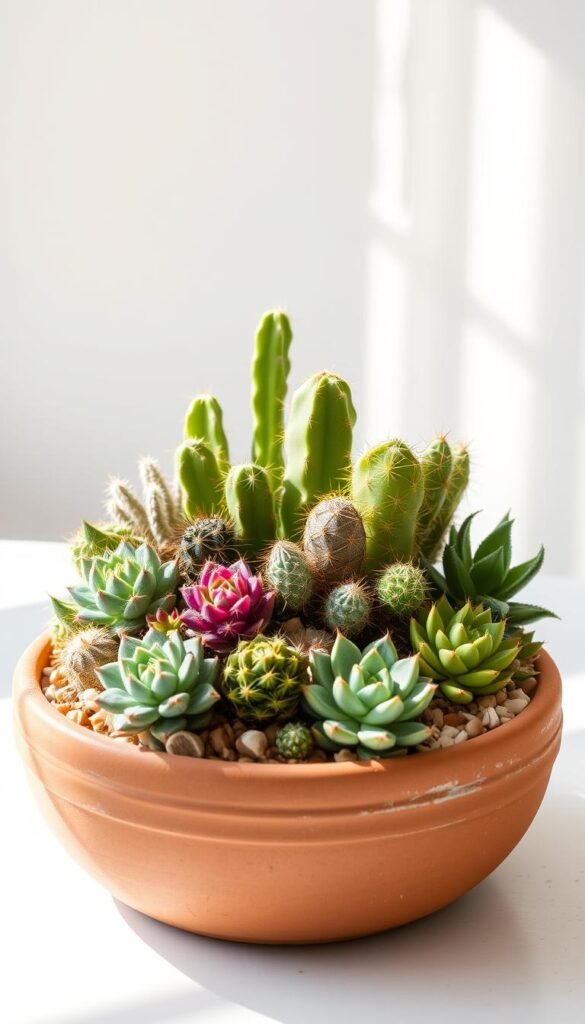Imagine bringing a slice of the desert into your living space with a vibrant, self-contained ecosystem. Miniature landscapes in shallow containers offer an easy way to add natural beauty to your home while fitting busy lifestyles. These arrangements combine multiple low-maintenance plants in creative designs, perfect for brightening shelves, desks, or coffee tables.
While both options thrive indoors, their care needs differ significantly. One type thrives on neglect, needing water only occasionally, while others prefer slightly more attention. The key lies in understanding their unique watering rhythms and how they interact in shared containers. For example, proper cactus care requires specific soil blends and drainage strategies to prevent root rot.
Your choice depends on three factors: available space, sunlight patterns, and how often you remember to tend to greenery. South-facing windows work better for some varieties, while others adapt to indirect light. Consider your experience level too – some setups forgive occasional missed waterings better than others.
In this guide, you’ll learn how to match these living art pieces to your routine and decor. We’ll break down their growth habits, ideal placements, and long-term upkeep so you can confidently choose your new favorite conversation starter.
Understanding the Basics of Dish Gardens
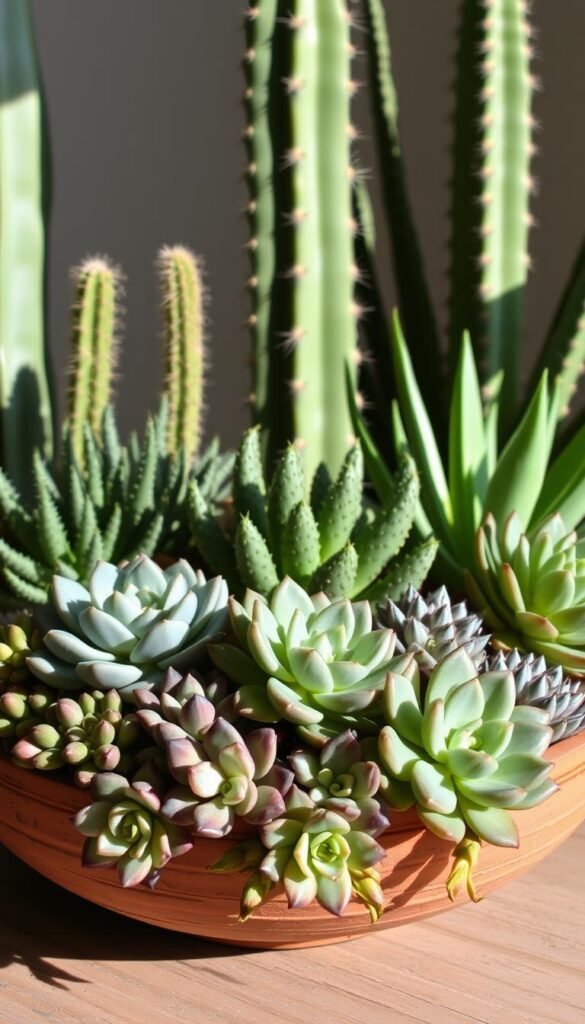
Transform any room with a living mosaic that’s as easy to maintain as it is beautiful. These miniature ecosystems combine carefully chosen greenery in shallow pots, blending practicality with artistic design. Let’s break down what makes these arrangements work.
What Is a Dish Garden?
Think of these setups as tiny landscapes where plants coexist in harmony. Unlike single-species pots, they mix textures and colors to mimic natural environments. Their shallow depth limits root growth, keeping plants compact and low-maintenance.
Essential Elements: Containers, Soil, and Drainage
Containers set the stage for success. Terra cotta breathes well, ceramic adds style, and metal offers modern flair. Always check depth – 2-4 inches works best for most roots.
Your soil mix matters more than you’d guess. Combine standard potting soil with coarse sand (1:1 ratio) for quick drainage. This prevents soggy roots while giving plants firm footing.
No drain holes? Layer pebbles and charcoal at the pot’s base. This trick pulls excess moisture away from roots, acting like an emergency exit for unwanted water. Pair this with careful watering to keep plants thriving for years.
Choosing Between Cactus Dish Garden vs. Succulent Dish Garden: Which is Best for You?
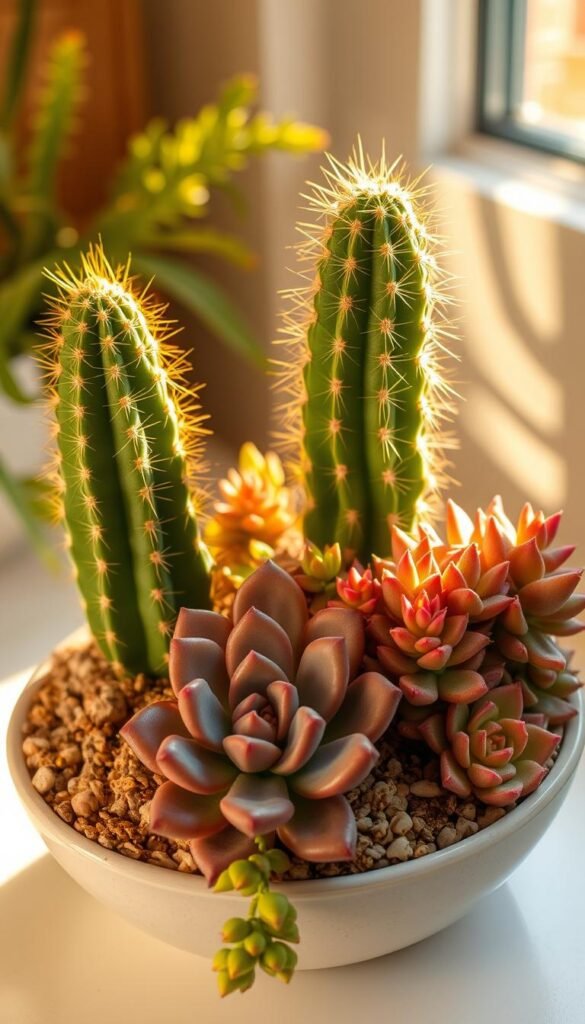
Creating a thriving miniature ecosystem depends on pairing plants with similar care needs. Let’s explore how water habits and light preferences determine which arrangement suits your home best.
Water Wisdom and Plant Partnerships
Desert natives like cacti store water for months, needing drinks every 4-6 weeks. Other succulents prefer hydration every 2-3 weeks. Mixing these groups risks root rot in one plant while starving another.
Popular drought-tolerant companions include jade plants and snake plants. These handle dry spells better than moisture-loving varieties. Always use fast-draining soil to prevent soggy roots between waterings.
Light Levels and Growth Patterns
South-facing windows work best for sun-hungry cacti. Many succulents thrive in bright indirect light, making them flexible for east or west exposures. Rotate containers weekly for even growth.
Key Considerations Compared
- Low-maintenance choice: Cacti setups ideal for forgetful waterers
- Visual variety: Succulent mixes offer more leaf shapes and colors
- Space needs: Vertical cacti save counter space vs. spreading succulents
During winter dormancy, both types need half their usual water. Stick your finger in the soil – if it’s dry two inches down, it’s safe to water. This simple test keeps your green friends happy year-round.
Step-by-Step Guide to Creating Your Dish Garden
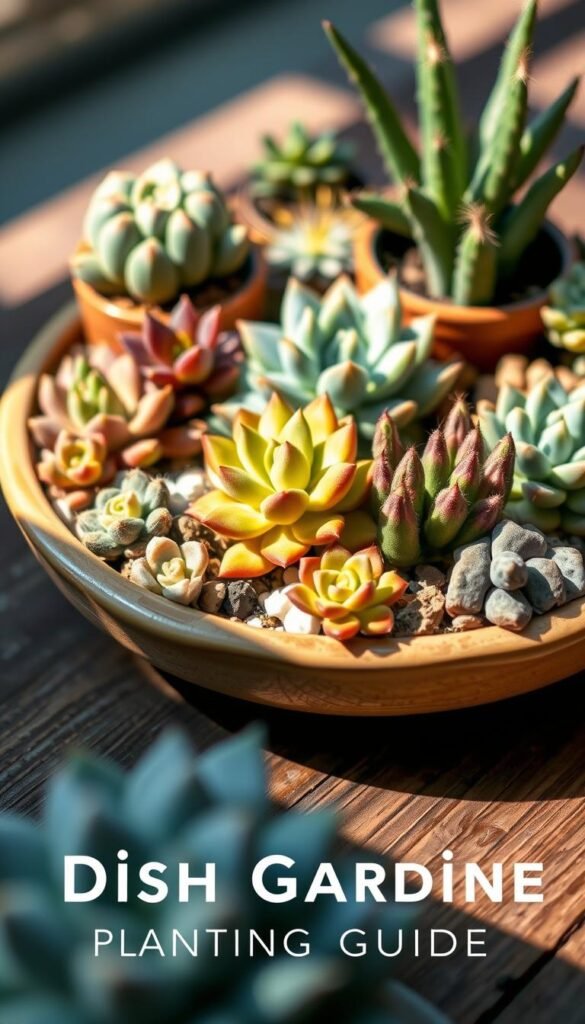
Ready to craft your own living masterpiece? Let’s walk through the essentials for building a thriving miniature ecosystem. With the right materials and techniques, you’ll create a stunning display that evolves beautifully over time.
Pre-Planting Preparation and Material Selection
Start with 3-4 inch plants for compact designs or mix 6-inch and 4-inch varieties in larger containers. Your soil blend is crucial – combine equal parts standard potting soil and cactus mix for optimal drainage. Add a charcoal layer at the container’s base to absorb odors and prevent root rot.
Water your green companions 48 hours before transplanting to reduce shock. Healthy roots should appear white or light-colored – avoid plants with mushy or discolored stems. For extra nutrients, mix in compost when preparing your soil.
Planting Techniques and Arrangement Tips
Position each plant slightly higher than the soil surface to account for settling. Group odd numbers of plants (3, 5, or 7) for natural-looking compositions. Pair tall, spiky varieties with trailing types and rounded shapes to create contrast.
Leave at least two finger-widths between plants for future growth. This complete dish gardening guide recommends using 2-4 inch specimens in small pots to prevent overcrowding. Water lightly after planting, then wait a week before the next drink to let roots establish.
Creative Design Ideas for Your Dish Garden
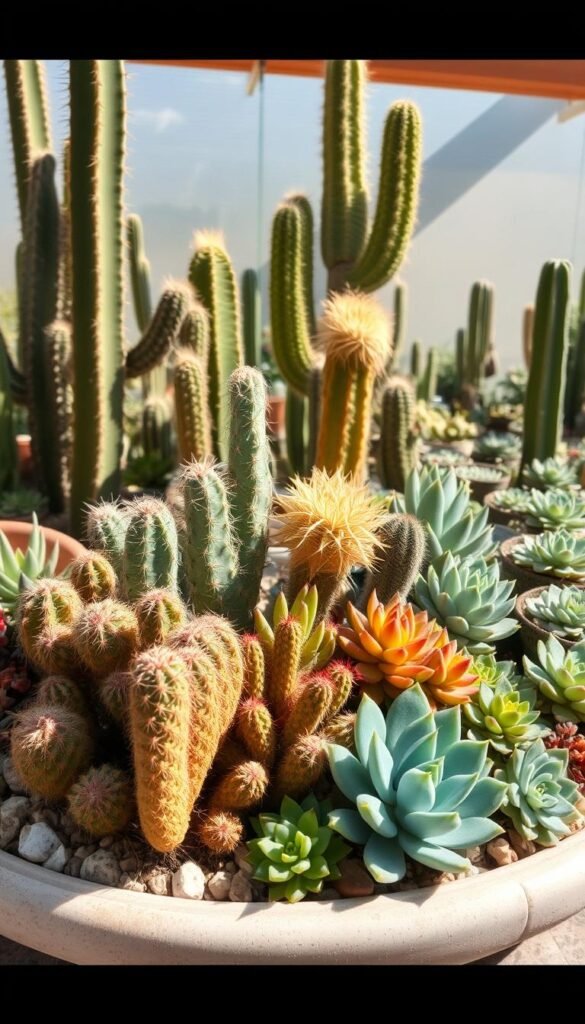
Turn your container into a living canvas that reflects your personality. Whether you prefer sleek modern lines or storybook charm, these arrangements let you play designer while keeping plants healthy. Balance bold aesthetics with practical care needs for a display that grows better with time.
Container Choices and Topdressing Inspirations
Think beyond basic pots. Upcycle vintage teacups for cottagecore vibes or use geometric concrete planters for urban edge. Hunt flea markets for weathered wooden bowls or colorful resin trays that match your room’s color scheme.
| Material | Best For | Style Examples |
|---|---|---|
| Terra Cotta | Desert themes | Southwestern patterns |
| Ceramic | Modern spaces | Glazed ombre finishes |
| Resin | Child-friendly areas | Mini construction vehicles |
| Repurposed Items | Eclectic decor | Antique jewelry boxes |
Top with decorative gravel to reduce soil evaporation. Try crushed turquoise stones for pop or black lava rock for contrast. Moss varieties like sheet or cushion types add texture while helping retain moisture.
Incorporating Decorative Elements
Place miniature fairy houses among succulents for playful energy. Use polished river stones to guide the eye through your dish’s “landscape”. For coastal themes, arrange seashells and bleached driftwood like beachside treasures.
Remember: decorations shouldn’t crowd plants. Leave space for growth and air circulation. Test accessories for sharp edges that could damage leaves. With smart placement, your bowl becomes a conversation piece that thrives in its location for years.
Maintenance & Troubleshooting for Your Mini Landscape
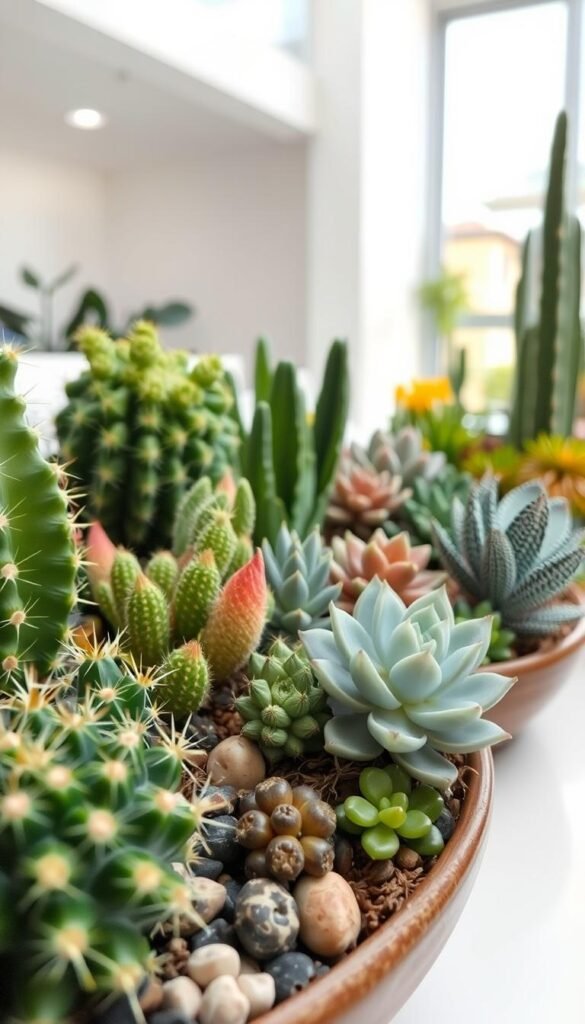
Keep your living artwork thriving with simple routines tailored to its unique needs. Unlike traditional houseplants, these compact ecosystems demand precise care to maintain their balance. Let’s explore how to protect your investment while enjoying its evolving beauty.
Watering, Lighting, and Seasonal Adjustments
Target water directly at root zones using a narrow-spout can. This prevents soggy soil in unused areas – a common cause of root rot. During summer, hydrate every 14 days, extending to 25-30 days in winter dormancy. Always check soil dryness two inches deep before watering.
Position sun-loving arrangements near south windows, but shield mixed planters with sheer curtains. Rotate your pot weekly for even growth. If leaves stretch or fade, adjust their light exposure gradually over 5-7 days.
Feed plants once each spring with diluted 5-5-5 fertilizer. Top dress with worm compost to refresh nutrients without disturbing roots. For smart watering techniques, water in the morning so excess moisture evaporates by nightfall.
Watch for webbing between leaves (spider mites) or white fluff (mealybugs). Isolate affected plants immediately and treat with neem oil sprays. Prune overcrowded stems in early spring using sterilized scissors to maintain airflow and shape.
When temperatures drop, reduce watering frequency by half. Most varieties tolerate indoor winter air but keep them away from drafty windows. Come spring, refresh topsoil and check for root-bound plants needing division.
Final Thoughts on Cultivating Your Dish Garden
Your living arrangement evolves as its green residents grow, offering fresh beauty with each season. Successful dish gardens aren’t static displays – they’re dynamic partnerships between you and your plants. Over time, you’ll need to replace outgrown specimens or refresh the mix, much like updating decor to match your changing tastes.
Whether drawn to sculptural cacti or varied succulents, your choice reflects personal style and routine. Sun-loving varieties demand bright spots but forgive occasional neglect, while moisture-sensitive mixes thrive with attentive care. Matching plant needs to your schedule and space ensures lasting enjoyment.
Remember: compatibility matters most. Pair slow-growing types that share light and water preferences. Observe how leaves and stems interact as they mature – some combinations create stunning contrasts, while others compete for resources.
With thoughtful selection and simple maintenance, these miniature ecosystems become living heirlooms. They’ll adapt alongside you, offering quiet satisfaction as new growth emerges. Start small, learn through seasons, and watch your confidence bloom alongside your green companions.

